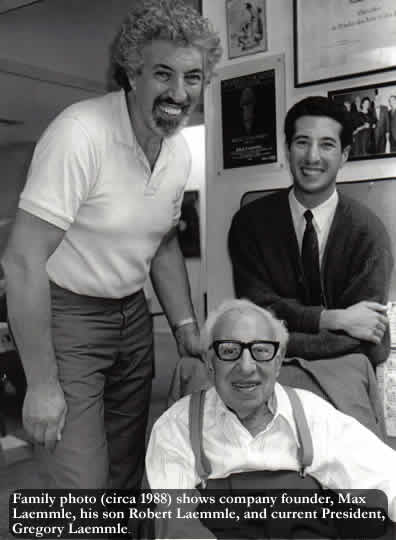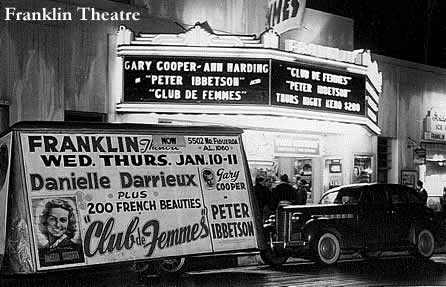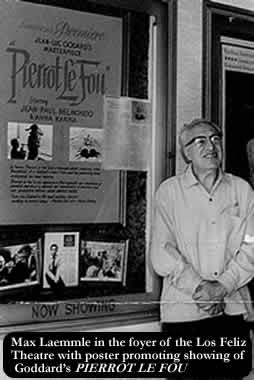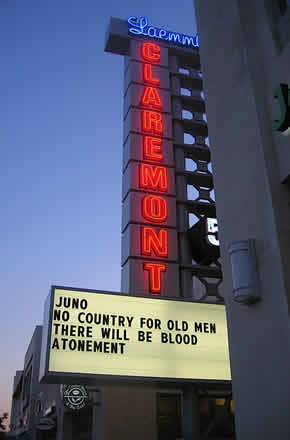 In 1938 the first Laemmle’s Theaters were opened in Los Angeles by Max Laemmle, and his brother, Kurt. Since then, the Laemmle’s Theater chain has vastly expanded, growing their reach throughout Southern California. Over time, Laemmle’s Theater’s have become the leaders in showcasing art house, independent, and foreign film in the Los Angeles area. There are currently seventeen Laemmle’s locations, and the chain has recently added a five-plex theater in Claremont, and has plans to add a seven-screen complex in the north Hollywood arts district. Throughout their expansion and success, Laemmle’s Theater has remained a family owned business. Greg Laemmle, the Grandson of Max, currently runs the day-to-day operations for Laemmle’s Theaters
In 1938 the first Laemmle’s Theaters were opened in Los Angeles by Max Laemmle, and his brother, Kurt. Since then, the Laemmle’s Theater chain has vastly expanded, growing their reach throughout Southern California. Over time, Laemmle’s Theater’s have become the leaders in showcasing art house, independent, and foreign film in the Los Angeles area. There are currently seventeen Laemmle’s locations, and the chain has recently added a five-plex theater in Claremont, and has plans to add a seven-screen complex in the north Hollywood arts district. Throughout their expansion and success, Laemmle’s Theater has remained a family owned business. Greg Laemmle, the Grandson of Max, currently runs the day-to-day operations for Laemmle’s Theaters
Bijan Tehrani: Please tell us a little bit about the background of Laemmle’s. How was it started, what was the goal, and how was it expanded?
Greg Laemmle: Laemmle’s Theater started in 1938 in Los Angeles when my grandfather, Max Laemmle, who was doing independent distribution in Europe, realized that it was no longer safe to be in Europe as a Jew. His brother Kurt was running a movie theater in the Midwest here in the United States, and suggested to Max to bring his family to the United States to run movie theaters. My grandfather was an asthmatic, and told his brother that the Midwest would not work for him, but that he had been to Los Angeles and knew that there was a large German expatriate population there that would be conducive for them and their parents. So they settled on Los Angeles and opened up two neighborhood movie theaters in the Highland Park area in Los Angeles and basically began as a mom and pop neighborhood theater chain with those two theaters. There was no specific focus on playing foreign films at that time. As the neighborhood chain started dying off in the late 1940’s after television came in, my Uncle Kurt had to leave the business because there was no enough income to support the two families, and my grandfather started focusing more and more on playing reparatory and foreign film. Focus on foreign film continued growing as the New Wave and neo-realist films evolved from Italy, as did the post-war films from Japan and then the French New Wave films. My father joined the circuit in the mid-sixties and we have been expanding ever since.
BT: Do those early theaters still exist?
GL: I don’t believe so. But one of the neighborhood theaters, at the time there were six neighborhood theaters, one of which was the Los Feliz Theater. As the circuit contracted that became the remaining theater. As we transitioned into an art house chain, many people saw their first and seminal art house films at the Los Feliz. We have posters showing the new Pierrot le Fou and reissues of Chimes at Midnight and Fallstaff. It was a much-loved venue as there was this transition from neighborhood to foreign. Also an interesting transition was that many of the Theaters specializing in playing foreign films in the sixties started playing X rated films instead. So We were not prepared to go in that direction, and the Los Feliz, which had not necessarily been the most important theater for foreign language films, by virtue of still remaining true to that calling, started playing more and more of the important foreign language films.
circuit contracted that became the remaining theater. As we transitioned into an art house chain, many people saw their first and seminal art house films at the Los Feliz. We have posters showing the new Pierrot le Fou and reissues of Chimes at Midnight and Fallstaff. It was a much-loved venue as there was this transition from neighborhood to foreign. Also an interesting transition was that many of the Theaters specializing in playing foreign films in the sixties started playing X rated films instead. So We were not prepared to go in that direction, and the Los Feliz, which had not necessarily been the most important theater for foreign language films, by virtue of still remaining true to that calling, started playing more and more of the important foreign language films.
BT: Do you remember the very first foreign movie that was played in a Laemmle’s Theater?
GL: We don’t. There is an early photograph we have, even dating back to the days when it was a neighborhood chain when they would still play the occasional foreign film. It’s not as if they ever turned their back on it. I’m sure they were occasionally playing the pre-war films of genre noir.
BT: Do you see a change in the audience responses to foreign movies? Are there more audiences coming to see foreign movies during recent years?
GL: I don’t know that foreign films have the same cultural cache that they may have had in the late sixties and seventies. At some level they have been supplanted by American independent films in that regard. But I do believe that there is a willingness on the part of even a broad commercial audience now to embrace the occasional foreign film. They are not going for the more esoteric films naturally, but some titles are not necessarily the barrier they used to be in a theatrical environment, and people just want to see good films.
BT: What has been the most successful foreign language film you have shown in the last year?
GL: Probably the most successful this past year has been The Lives of Others. This was a terrific phenomenon because it was a very difficult and brilliant film, and one that had a very long run. It must have played out for six months or more. It was fabulous because it was a style of theatrical release that isn’t seen these days. Now a day if something shows any success it is in 3,000 theaters all of the sudden, and three months, three weeks later, it is gone. So to have the film play out over six months was like it used to be. And it showed the power of word of mouth at some level, because it was clearly being driven by people who were saying, “I saw this film and I can’t stop thinking about it.” And, “You have to see this film.” And it would take people a while to find it, but they would eventually.
 BT: Do you think the Academy Awards helped?
BT: Do you think the Academy Awards helped?
GL: Clearly it helps. It is very important. Well, not every film that wins the Best Foreign Language category will be a box office success, but it certainly helped what was already a terrific film.
BT: Do you get any support from the people in the film industry that are thinking more about films that have more artistic value?
GL: No.
BT: Your existence and expansion is so important I think for cinema. Not only for international cinema, because I think international cinema is a part of cinema, because you see more films that are dealing with real subjects and real issues that are unfortunately coming from outside our country that are coming from here.
GL: I don’t think that is unfortunate, I think that is wonderful that we can have that cross-cultural exchange of ideas and viewpoints. I think that the support that the industry provides at some level is about finding new talent, and ways of using that talent to make Hollywood films, but they are not necessarily interested in promoting the audiences acceptance of non-Hollywood films. There is really no one necessarily out there cheerleading for seeing the newest dogma film from Denmark just for the sake of seeing that film and for the sake of that filmmaker making another film in Denmark. The whole point is I saw that film, it was terrific, I want him to make my next sci-fi action thriller.
BT: What percentage of the films that you show belong to American Independent filmmakers?
GL: My gut tells me more than fifty percent of the art house fair at this point is American Independent, with a significant portion of the remaining fifty percent being English language foreign film, so films most specifically from England. We are not seeing quite as much independent film from Australia, it goes up and down in other parts in the English-speaking world. And then you have foreign language films being thirty percent of the art house films that are being seen by the audiences.
BT: Do you see any growth in the number of American Independent films produced?
GL: There are certainly more films being produced, and more films being released with out a doubt. Quite a few documentaries. We are seeing a lot more American independent documentaries, we are not seeing as many foreign documentaries, many of which are quite intriguing but they are just getting crowded out of the market place.
documentaries, many of which are quite intriguing but they are just getting crowded out of the market place.
BT: Documentaries are not supposed to be a great event for the box office, are they making money now?
GL: They are. There is always this perception that maybe they are not making as much as people thought they would be making, but there is a part of me that feels that at least from a commercial stand point that I have an easier time getting an audience to a documentary than to a no-budget, no-name American independent film. It can be very difficult, but it’s more about marketing, not about the quality of filmmaking necessarily. With a documentary you often have a very specific audience that you can approach and get people interested.
BT: How many theaters are around right now with Laemmle’s?
GL: We have 49 screens at ten locations. Many of the screens our theaters play a mix of Hollywood films and foreign films, so in terms of the core theaters devoted to art house, you are talking about thirty or so.
BT: Do you run any kind of events during the year besides the usual screenings?
GL: We don’t necessarily run too many things. We are open to working with outside parties for film festivals and other programs. It’s just not the way we are set up.
BT: Are there any plans for the future?
GL: We are always looking at adding screens. We just opened a new five-plex movie theater in Claremont, which is a college-town suburb of Los Angeles. We have announced plans to open a seven-screen complex in the north Hollywood arts district. Were opportunity presents itself we are expanding, but we are basically a local Los Angeles company, and for the time being we will remain that way.
BT: Are there any new foreign films in June that you are screening for the first time?
GL: Always. One film that I particularly like and would recommend at the end of May is Fatih Akin’s film, Edge of Heaven.
BT: That is a wonderful film
GL: It’s a terrific film. He is a fabulous filmmaker. I was just blown away by Head On. I hadn’t seen anything quite as bracing in many years. And then to his documentary film, Crossing the Bridge, was very interesting–a terrific use  of the form. And then Edge of Heaven is in many ways so completely different, and yet just so fabulous.
of the form. And then Edge of Heaven is in many ways so completely different, and yet just so fabulous.
BT: It is a pity it wasn’t even considered as a nominee for the Academy Awards.
GL: That’s correct. It did not make the short list and was not ultimately considered.
BT: I think it is one of the most beautiful films in the last decade.
GL: Yes. And an important film because in a sense it is just about so many things. An important film for this country, about issues of immigration and integration into society, issues of cross cultural understanding, forgiveness, and ability to transcend.
BT: Thank you for your time
GL: My pleasure.

